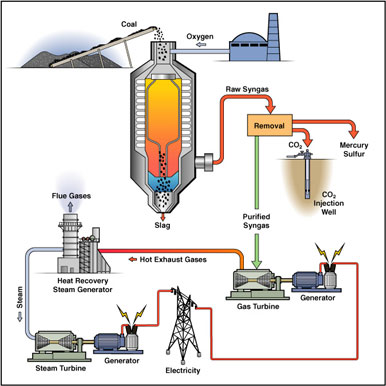Carbon Sequestration
WHAT IS CCS?
Carbon capture and sequestration (CCS) is a ‘clean coal’ technology in which the CO2 generated during the combustion of fossil fuels is captured and then stored in underground or underwater geologic formations (Haszeldine, 2009). CCS technology has already been used at ethanol refineries and natural processing plants, but has only recently been applied to coal combustion (Haszeldine, 2009).

HOW DOES CCS WORK?
Currently, there are several CCS technologies that are being explored and further developed at different test sites around the world. These technologies include: 1) precombustion capture; 2) post combustion capture; 3) and oxyfuel combustion. Precombustion capture "chemically strips€¦the carbon" (Haszeldine, 2009) off of the coal, leaving only hydrogen to burn during the combustion phase. Postcombustion capture separates the CO2 from the rest of the gaseous emissions immediately following the combustion process with the use of chemical solvents (Chu, 2009). Finally, oxyfuel combustion burns coal in denitrified air to yield only CO2 and water (Chu, 2009).
Once the CO2 has been captured, the same steps are used for all captured CO2 throughout the remainder of the process. The CO2 is pressurized to approximately 70 bar, a pressure at which the CO2 forms a liquid that can be more easily transported via pipeline to a storage site (Schrag, "Storage of Carbon Dioxide in Offshore Sediments").
At the storage site the fluid is injected into rock pores over 800 m below the surface (Heszeldine, 2009). This injection site can either be located under dry ground or under the ocean.
[kml_flashembed movie=”http://www.youtube.com/v/NctT7VMTpPg” width=”425″ height=”350″ wmode=”transparent” /]
Proponents of CCS argue that it can:
- Reduce greenhouse gas (GHG) emissions
- Reduce dependence on oil
- Support domestic jobs through the mining, transportation and combustion of coal
- Provide a reliable base generation capacity for the electric grid (Chu, 2009)
PROBLEMS WITH A CCS SYSTEM:
Although, CCS technologies do have the tantalizing potential to offer a carbon free coal power generation process, there are many problems with the technology. These problems exist throughout all three stages of CCS technology.
Capture:
- If scaled up, CO2 separation could consume 25 to 40% of the fuel energy of a power plant. This would lead to a price increase of almost 70% for coal power plants utilizing CCS technology (Schrag, “Marketing Carbon Capture and Storage Work”)
- The heating of the solvent used in postcombustion capture can produce a toxic byproduct (Haszeldine, 2009)
Transport:
- Would require extensive pipelines connecting point sources of CO2 emissions to individual storage sites (Schrag, “Storage of Carbon Dioxide in Offshore Sediments”)
- Maintaining proper pressure during transport would be challenging (Haszeldine, 2009)
Storage:
- Extremely large volumes of geologic storage space are needed in the right places and at the right time
- Current technology used in fluid injection fills only 0.2% of the pore space, not the 9% used to calculate storage potential. This means that actual fluid storage space with current technology can be as low as 1/45th of the storage space estimates (Haszeldine, 2009)
- Hydrate ice crystallization (crystal form of the fluid) could close up the boreholes, making continued injection of fluid more difficult (Chu, 2009)